wheel FORD ESCAPE 2022 Owners Manual
[x] Cancel search | Manufacturer: FORD, Model Year: 2022, Model line: ESCAPE, Model: FORD ESCAPE 2022Pages: 585, PDF Size: 6.15 MB
Page 5 of 585
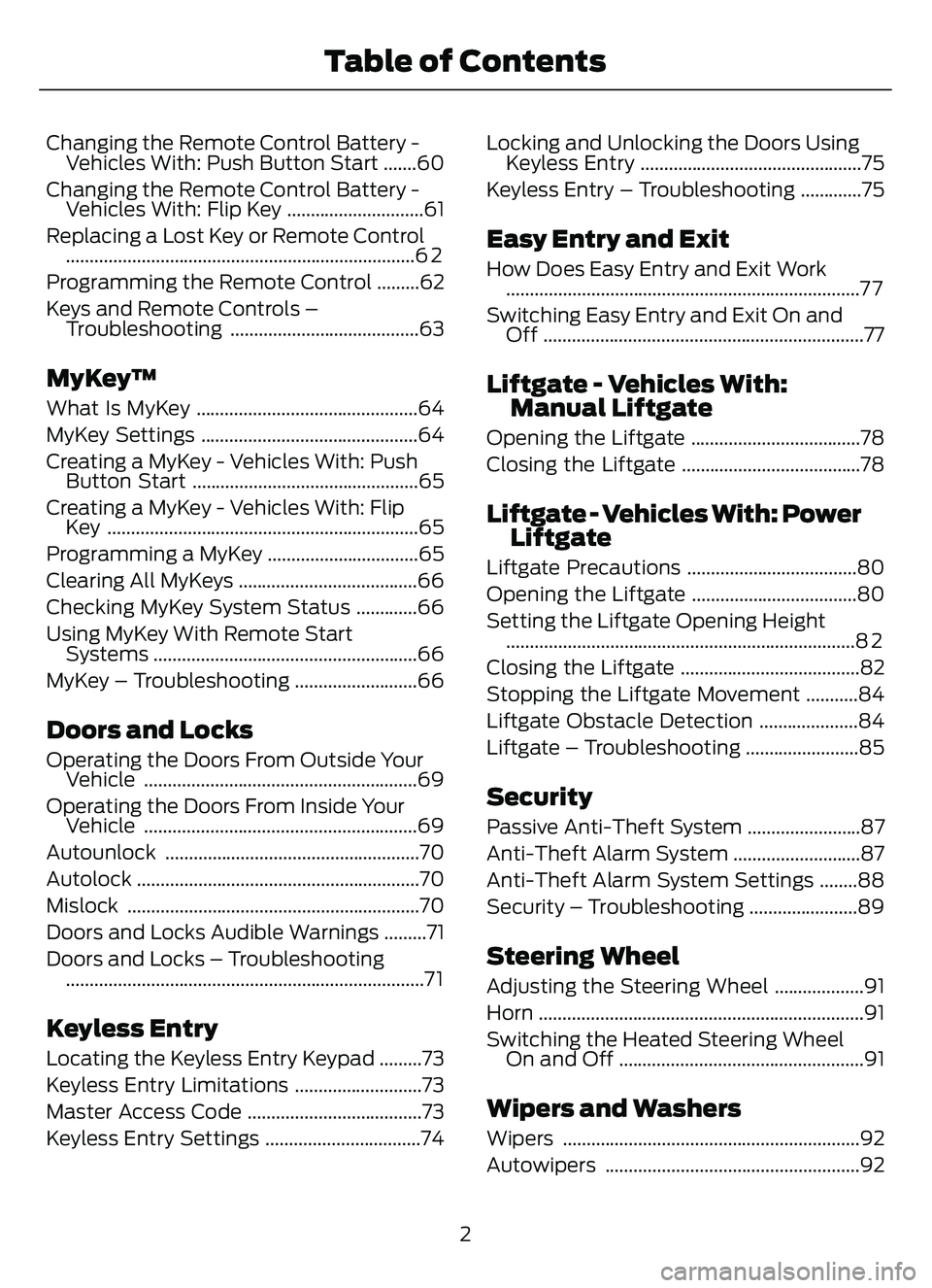
Changing the Remote Control Battery -Vehicles With: Push Button Start .......60
Changing the Remote Control Battery - Vehicles With: Flip Key .............................61
Replacing a Lost Key or Remote Control ........................................................................\
..6 2
Programming the Remote Control .........62
Keys and Remote Controls – Troubleshooting ........................................63
MyKey™
What Is MyKey ...............................................64
MyKey Settings ..............................................64
Creating a MyKey - Vehicles With: PushButton Start ................................................65
Creating a MyKey - Vehicles With: Flip Key ..................................................................65
Programming a MyKey ................................65
Clearing All MyKeys ......................................66
Checking MyKey System Status .............66
Using MyKey With Remote Start Systems ........................................................66
MyKey – Troubleshooting ..........................66
Doors and Locks
Operating the Doors From Outside Your Vehicle ..........................................................69
Operating the Doors From Inside Your Vehicle ..........................................................69
Autounlock ......................................................70
Autolock ............................................................70
Mislock ..............................................................70
Doors and Locks Audible Warnings .........71
Doors and Locks – Troubleshooting ........................................................................\
....7 1
Keyless Entry
Locating the Keyless Entry Keypad .........73
Keyless Entry Limitations ...........................73
Master Access Code .....................................73
Keyless Entry Settings .................................74 Locking and Unlocking the Doors Using
Keyless Entry ...............................................75
Keyless Entry – Troubleshooting .............75
Easy Entry and Exit
How Does Easy Entry and Exit Work ........................................................................\
...7 7
Switching Easy Entry and Exit On and Off ....................................................................77
Liftgate - Vehicles With:Manual Liftgate
Opening the Liftgate ....................................78
Closing the Liftgate ......................................78
Liftgate - Vehicles With: PowerLiftgate
Liftgate Precautions ....................................80
Opening the Liftgate ...................................80
Setting the Liftgate Opening Height........................................................................\
..8 2
Closing the Liftgate ......................................82
Stopping the Liftgate Movement ...........84
Liftgate Obstacle Detection .....................84
Liftgate – Troubleshooting ........................85
Security
Passive Anti-Theft System ........................87
Anti-Theft Alarm System ...........................87
Anti-Theft Alarm System Settings ........88
Security – Troubleshooting .......................89
Steering Wheel
Adjusting the Steering Wheel ...................91
Horn .....................................................................91
Switching the Heated Steering Wheel On and Off ....................................................91
Wipers and Washers
Wipers ...............................................................92
Autowipers ......................................................92
2
Table of Contents
Page 10 of 585
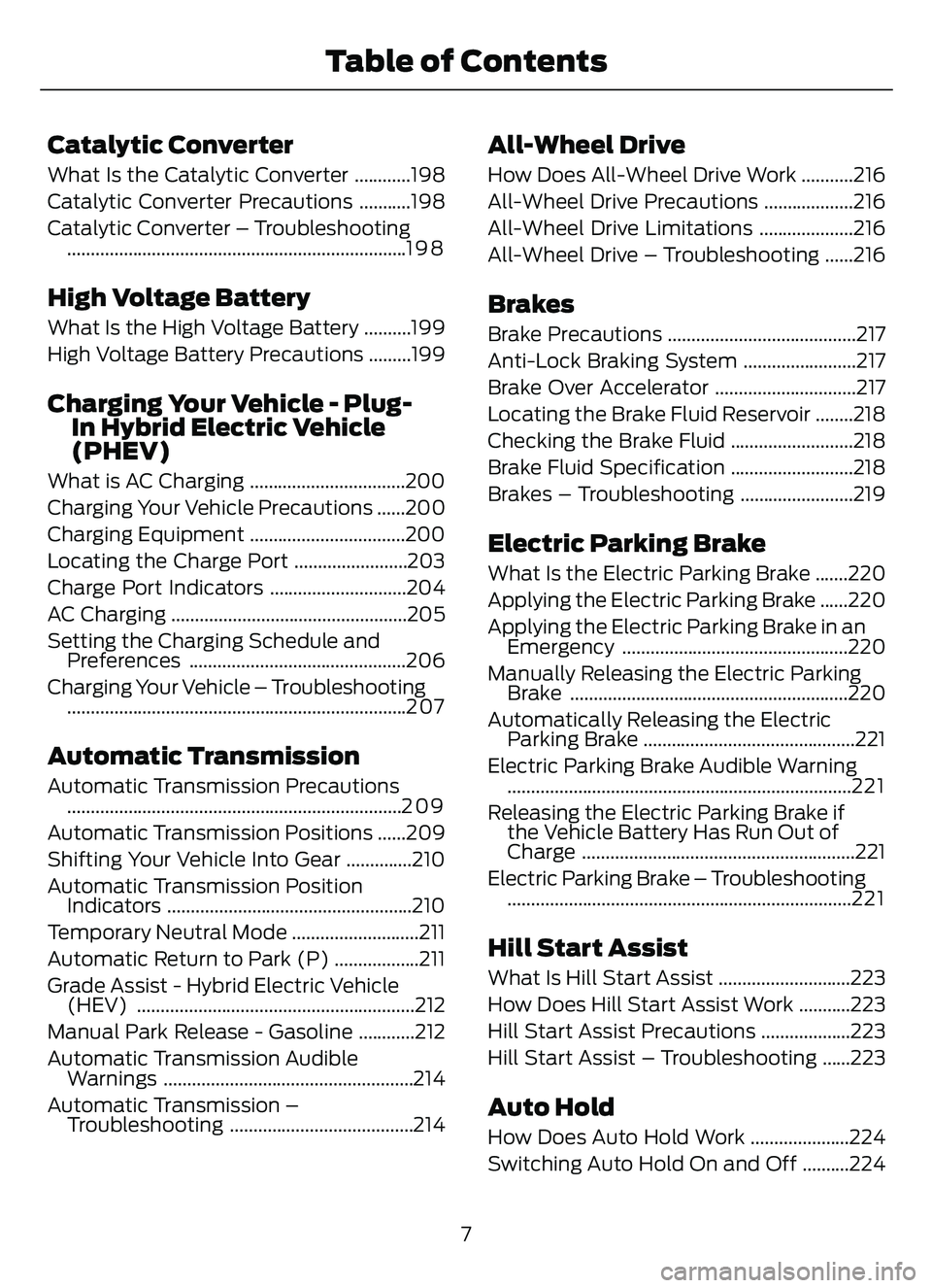
Catalytic Converter
What Is the Catalytic Converter ............198
Catalytic Converter Precautions ...........198
Catalytic Converter – Troubleshooting........................................................................\
1 9 8
High Voltage Battery
What Is the High Voltage Battery ..........199
High Voltage Battery Precautions .........199
Charging Your Vehicle - Plug-In Hybrid Electric Vehicle
(PHEV)
What is AC Charging .................................200
Charging Your Vehicle Precautions ......200
Charging Equipment .................................200
Locating the Charge Port ........................203
Charge Port Indicators .............................204
AC Charging ..................................................205
Setting the Charging Schedule andPreferences ..............................................206
Charging Your Vehicle – Troubleshooting ........................................................................\
207
Automatic Transmission
Automatic Transmission Precautions.......................................................................2\
0 9
Automatic Transmission Positions ......209
Shifting Your Vehicle Into Gear ..............210
Automatic Transmission Position Indicators ....................................................210
Temporary Neutral Mode ...........................211
Automatic Return to Park (P) ..................211
Grade Assist - Hybrid Electric Vehicle (HEV) ...........................................................212
Manual Park Release - Gasoline ............212
Automatic Transmission Audible Warnings .....................................................214
Automatic Transmission – Troubleshooting .......................................214
All-Wheel Drive
How Does All-Wheel Drive Work ...........216
All-Wheel Drive Precautions ...................216
All-Wheel Drive Limitations ....................216
All-Wheel Drive – Troubleshooting ......216
Brakes
Brake Precautions ........................................217
Anti-Lock Braking System ........................217
Brake Over Accelerator ..............................217
Locating the Brake Fluid Reservoir ........218
Checking the Brake Fluid ..........................218
Brake Fluid Specification ..........................218
Brakes – Troubleshooting ........................219
Electric Parking Brake
What Is the Electric Parking Brake .......220
Applying the Electric Parking Brake ......220
Applying the Electric Parking Brake in anEmergency ................................................220
Manually Releasing the Electric Parking Brake ...........................................................220
Automatically Releasing the Electric Parking Brake .............................................221
Electric Parking Brake Audible Warning ........................................................................\
.2 2 1
Releasing the Electric Parking Brake if the Vehicle Battery Has Run Out of
Charge ..........................................................221
Electric Parking Brake – Troubleshooting ........................................................................\
.2 2 1
Hill Start Assist
What Is Hill Start Assist ............................223
How Does Hill Start Assist Work ...........223
Hill Start Assist Precautions ...................223
Hill Start Assist – Troubleshooting ......223
Auto Hold
How Does Auto Hold Work .....................224
Switching Auto Hold On and Off ..........224
7
Table of Contents
Page 14 of 585
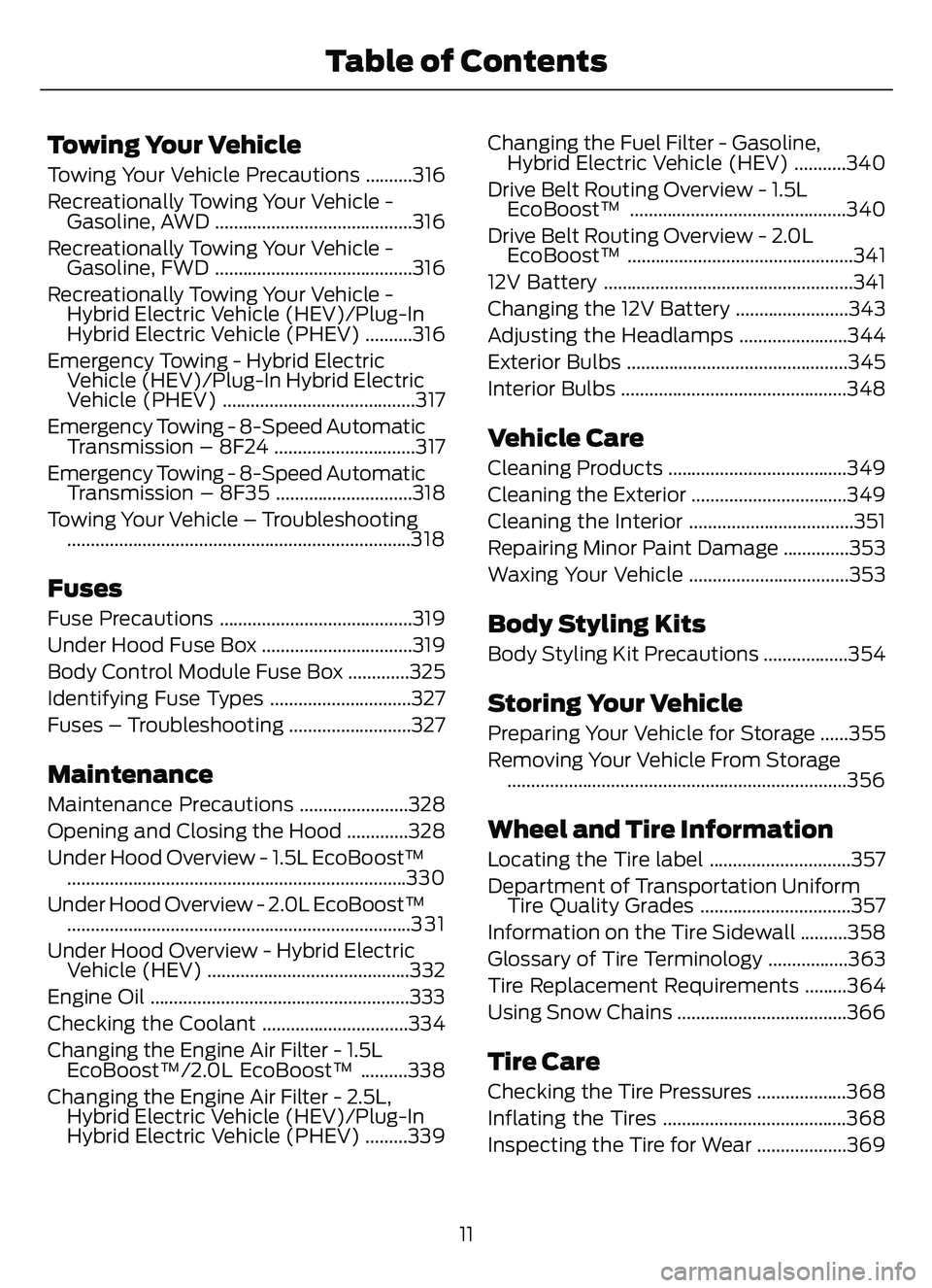
Towing Your Vehicle
Towing Your Vehicle Precautions ..........316
Recreationally Towing Your Vehicle -Gasoline, AWD ..........................................316
Recreationally Towing Your Vehicle - Gasoline, FWD ..........................................316
Recreationally Towing Your Vehicle - Hybrid Electric Vehicle (HEV)/Plug-In
Hybrid Electric Vehicle (PHEV) ..........316
Emergency Towing - Hybrid Electric Vehicle (HEV)/Plug-In Hybrid Electric
Vehicle (PHEV) .........................................317
Emergency Towing - 8-Speed Automatic Transmission – 8F24 ..............................317
Emergency Towing - 8-Speed Automatic Transmission – 8F35 .............................318
Towing Your Vehicle – Troubleshooting ........................................................................\
.318
Fuses
Fuse Precautions .........................................319
Under Hood Fuse Box ................................319
Body Control Module Fuse Box .............325
Identifying Fuse Types ..............................327
Fuses – Troubleshooting ..........................327
Maintenance
Maintenance Precautions .......................328
Opening and Closing the Hood .............328
Under Hood Overview - 1.5L EcoBoost™........................................................................\
330
Under Hood Overview - 2.0L EcoBoost™ ........................................................................\
.3 3 1
Under Hood Overview - Hybrid Electric Vehicle (HEV) ...........................................332
Engine Oil .......................................................333
Checking the Coolant ...............................334
Changing the Engine Air Filter - 1.5L EcoBoost™/2.0L EcoBoost™ ..........338
Changing the Engine Air Filter - 2.5L, Hybrid Electric Vehicle (HEV)/Plug-In
Hybrid Electric Vehicle (PHEV) .........339 Changing the Fuel Filter - Gasoline,
Hybrid Electric Vehicle (HEV) ...........340
Drive Belt Routing Overview - 1.5L EcoBoost™ ..............................................340
Drive Belt Routing Overview - 2.0L EcoBoost™ ................................................341
12V Battery .....................................................341
Changing the 12V Battery ........................343
Adjusting the Headlamps .......................344
Exterior Bulbs ...............................................345
Interior Bulbs ................................................348
Vehicle Care
Cleaning Products ......................................349
Cleaning the Exterior .................................349
Cleaning the Interior ...................................351
Repairing Minor Paint Damage ..............353
Waxing Your Vehicle ..................................353
Body Styling Kits
Body Styling Kit Precautions ..................354
Storing Your Vehicle
Preparing Your Vehicle for Storage ......355
Removing Your Vehicle From Storage ........................................................................\
356
Wheel and Tire Information
Locating the Tire label ..............................357
Department of Transportation UniformTire Quality Grades ................................357
Information on the Tire Sidewall ..........358
Glossary of Tire Terminology .................363
Tire Replacement Requirements .........364
Using Snow Chains ....................................366
Tire Care
Checking the Tire Pressures ...................368
Inflating the Tires .......................................368
Inspecting the Tire for Wear ...................369
11
Table of Contents
Page 15 of 585
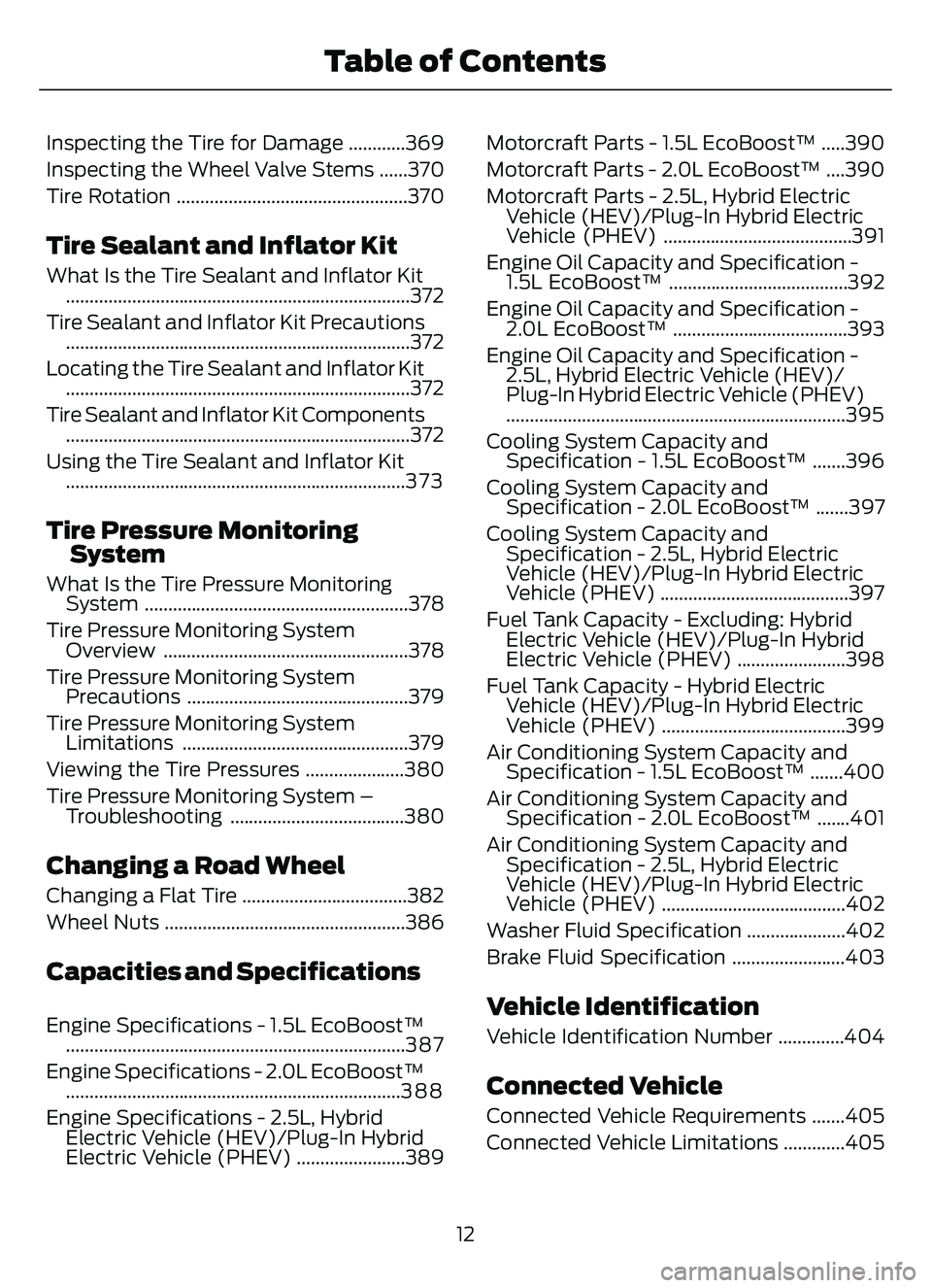
Inspecting the Tire for Damage ............369
Inspecting the Wheel Valve Stems ......370
Tire Rotation .................................................370
Tire Sealant and Inflator Kit
What Is the Tire Sealant and Inflator Kit........................................................................\
.372
Tire Sealant and Inflator Kit Precautions ........................................................................\
.372
Locating the Tire Sealant and Inflator Kit ........................................................................\
.372
Tire Sealant and Inflator Kit Components ........................................................................\
.372
Using the Tire Sealant and Inflator Kit ........................................................................\
3 7 3
Tire Pressure MonitoringSystem
What Is the Tire Pressure MonitoringSystem ........................................................378
Tire Pressure Monitoring System Overview ....................................................378
Tire Pressure Monitoring System Precautions ...............................................379
Tire Pressure Monitoring System Limitations ................................................379
Viewing the Tire Pressures .....................380
Tire Pressure Monitoring System – Troubleshooting .....................................380
Changing a Road Wheel
Changing a Flat Tire ...................................382
Wheel Nuts ...................................................386
Capacities and Specifications
Engine Specifications - 1.5L EcoBoost™........................................................................\
387
Engine Specifications - 2.0L EcoBoost™ .......................................................................3\
8 8
Engine Specifications - 2.5L, Hybrid Electric Vehicle (HEV)/Plug-In Hybrid
Electric Vehicle (PHEV) .......................389 Motorcraft Parts - 1.5L EcoBoost™ .....390
Motorcraft Parts - 2.0L EcoBoost™ ....390
Motorcraft Parts - 2.5L, Hybrid Electric
Vehicle (HEV)/Plug-In Hybrid Electric
Vehicle (PHEV) ........................................391
Engine Oil Capacity and Specification - 1.5L EcoBoost™ ......................................392
Engine Oil Capacity and Specification - 2.0L EcoBoost™ .....................................393
Engine Oil Capacity and Specification - 2.5L, Hybrid Electric Vehicle (HEV)/
Plug-In Hybrid Electric Vehicle (PHEV)
........................................................................\
395
Cooling System Capacity and Specification - 1.5L EcoBoost™ .......396
Cooling System Capacity and Specification - 2.0L EcoBoost™ .......397
Cooling System Capacity and Specification - 2.5L, Hybrid Electric
Vehicle (HEV)/Plug-In Hybrid Electric
Vehicle (PHEV) ........................................397
Fuel Tank Capacity - Excluding: Hybrid Electric Vehicle (HEV)/Plug-In Hybrid
Electric Vehicle (PHEV) .......................398
Fuel Tank Capacity - Hybrid Electric Vehicle (HEV)/Plug-In Hybrid Electric
Vehicle (PHEV) .......................................399
Air Conditioning System Capacity and Specification - 1.5L EcoBoost™ .......400
Air Conditioning System Capacity and Specification - 2.0L EcoBoost™ .......401
Air Conditioning System Capacity and Specification - 2.5L, Hybrid Electric
Vehicle (HEV)/Plug-In Hybrid Electric
Vehicle (PHEV) .......................................402
Washer Fluid Specification .....................402
Brake Fluid Specification ........................403Vehicle Identification
Vehicle Identification Number ..............404
Connected Vehicle
Connected Vehicle Requirements .......405
Connected Vehicle Limitations .............405
12
Table of Contents
Page 25 of 585
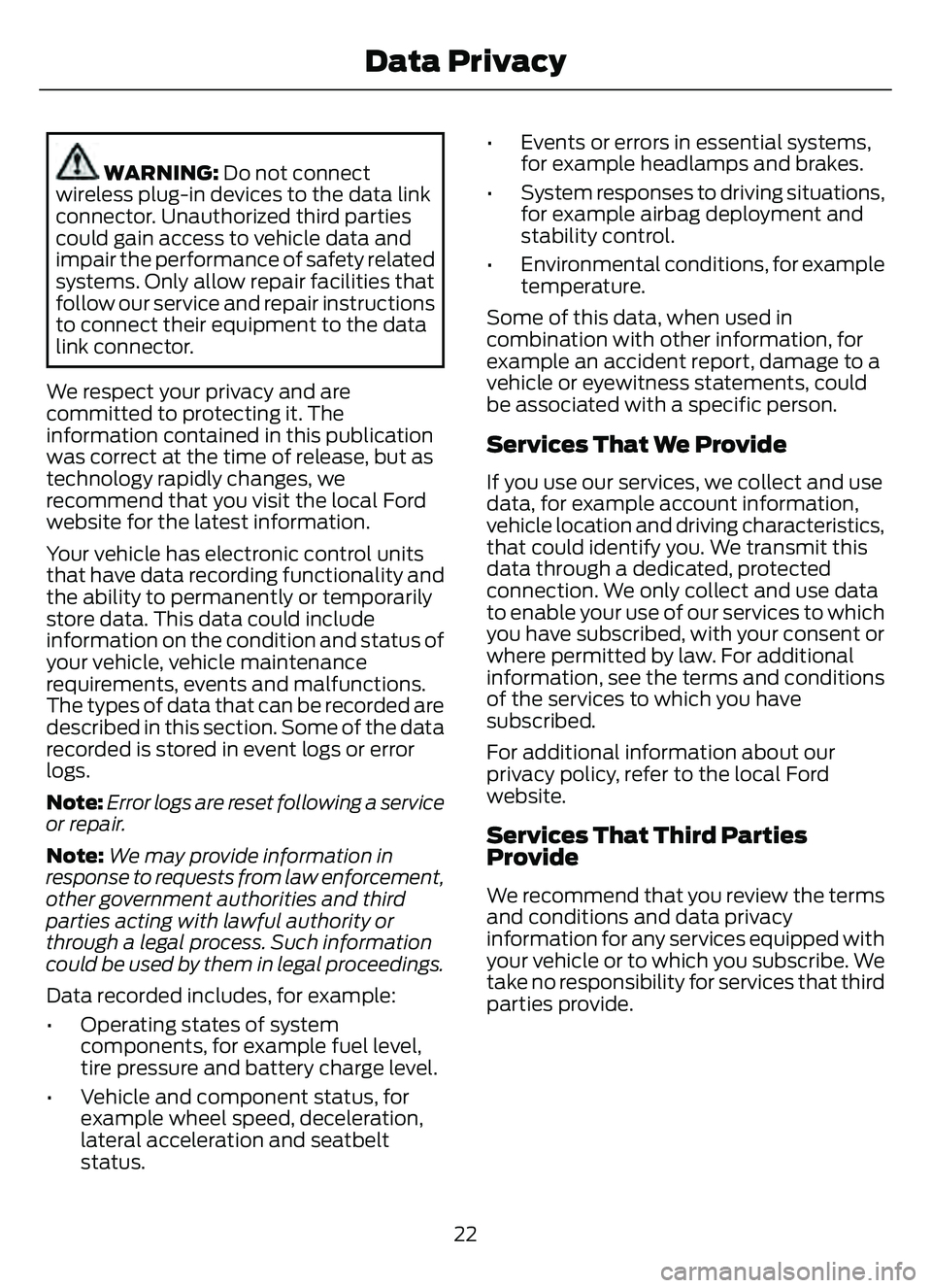
WARNING: Do not connect
wireless plug-in devices to the data link
connector. Unauthorized third parties
could gain access to vehicle data and
impair the performance of safety related
systems. Only allow repair facilities that
follow our service and repair instructions
to connect their equipment to the data
link connector.
We respect your privacy and are
committed to protecting it. The
information contained in this publication
was correct at the time of release, but as
technology rapidly changes, we
recommend that you visit the local Ford
website for the latest information.
Your vehicle has electronic control units
that have data recording functionality and
the ability to permanently or temporarily
store data. This data could include
information on the condition and status of
your vehicle, vehicle maintenance
requirements, events and malfunctions.
The types of data that can be recorded are
described in this section. Some of the data
recorded is stored in event logs or error
logs.
Note: Error logs are reset following a service
or repair.
Note: We may provide information in
response to requests from law enforcement,
other government authorities and third
parties acting with lawful authority or
through a legal process. Such information
could be used by them in legal proceedings.
Data recorded includes, for example:
• Operating states of system components, for example fuel level,
tire pressure and battery charge level.
• Vehicle and component status, for example wheel speed, deceleration,
lateral acceleration and seatbelt
status. • Events or errors in essential systems,
for example headlamps and brakes.
• System responses to driving situations, for example airbag deployment and
stability control.
• Environmental conditions, for example temperature.
Some of this data, when used in
combination with other information, for
example an accident report, damage to a
vehicle or eyewitness statements, could
be associated with a specific person.
Services That We Provide
If you use our services, we collect and use
data, for example account information,
vehicle location and driving characteristics,
that could identify you. We transmit this
data through a dedicated, protected
connection. We only collect and use data
to enable your use of our services to which
you have subscribed, with your consent or
where permitted by law. For additional
information, see the terms and conditions
of the services to which you have
subscribed.
For additional information about our
privacy policy, refer to the local Ford
website.
Services That Third Parties
Provide
We recommend that you review the terms
and conditions and data privacy
information for any services equipped with
your vehicle or to which you subscribe. We
take no responsibility for services that third
parties provide.
22
Data Privacy
Page 26 of 585
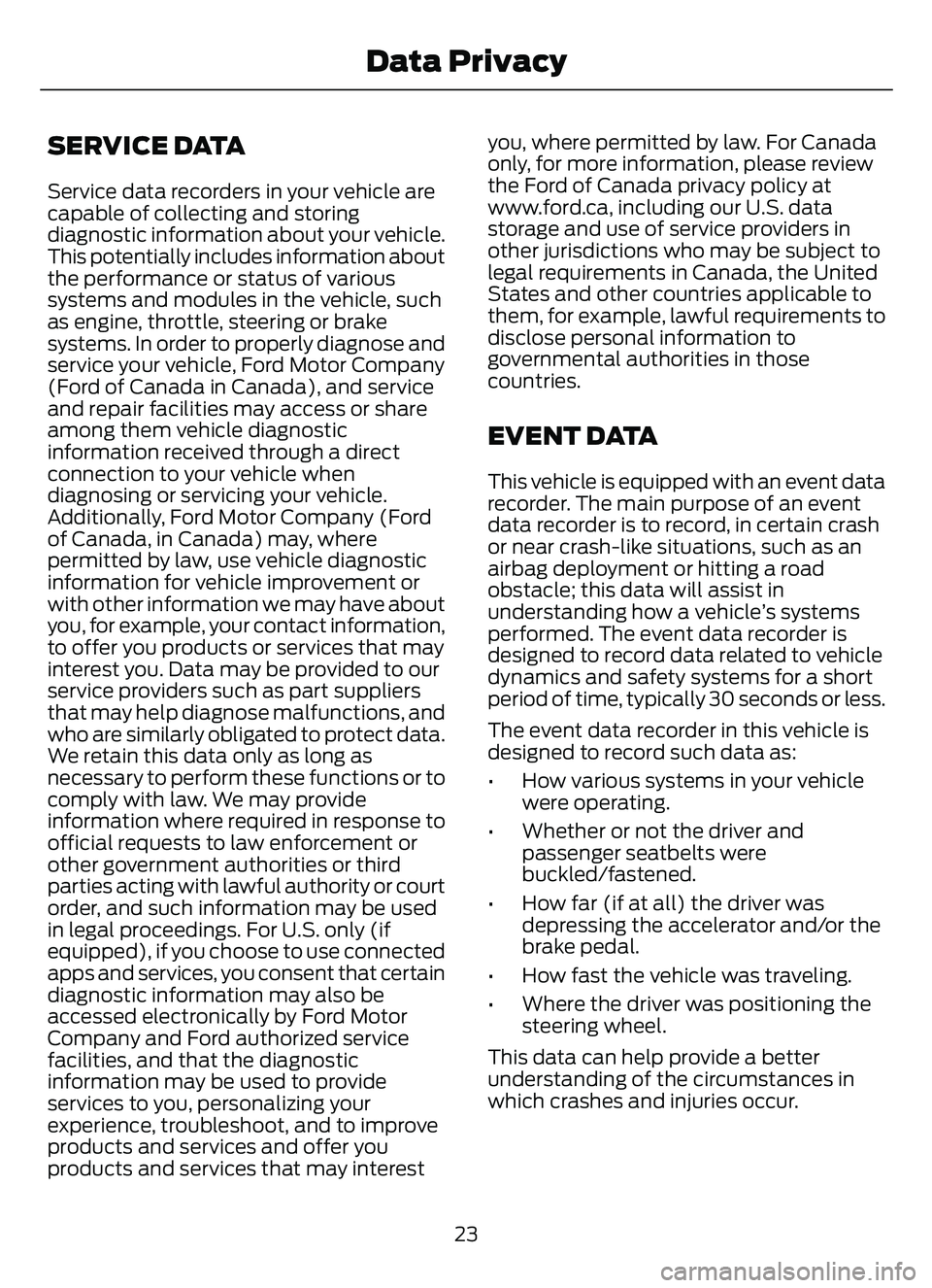
SERVICE DATA
Service data recorders in your vehicle are
capable of collecting and storing
diagnostic information about your vehicle.
This potentially includes information about
the performance or status of various
systems and modules in the vehicle, such
as engine, throttle, steering or brake
systems. In order to properly diagnose and
service your vehicle, Ford Motor Company
(Ford of Canada in Canada), and service
and repair facilities may access or share
among them vehicle diagnostic
information received through a direct
connection to your vehicle when
diagnosing or servicing your vehicle.
Additionally, Ford Motor Company (Ford
of Canada, in Canada) may, where
permitted by law, use vehicle diagnostic
information for vehicle improvement or
with other information we may have about
you, for example, your contact information,
to offer you products or services that may
interest you. Data may be provided to our
service providers such as part suppliers
that may help diagnose malfunctions, and
who are similarly obligated to protect data.
We retain this data only as long as
necessary to perform these functions or to
comply with law. We may provide
information where required in response to
official requests to law enforcement or
other government authorities or third
parties acting with lawful authority or court
order, and such information may be used
in legal proceedings. For U.S. only (if
equipped), if you choose to use connected
apps and services, you consent that certain
diagnostic information may also be
accessed electronically by Ford Motor
Company and Ford authorized service
facilities, and that the diagnostic
information may be used to provide
services to you, personalizing your
experience, troubleshoot, and to improve
products and services and offer you
products and services that may interestyou, where permitted by law. For Canada
only, for more information, please review
the Ford of Canada privacy policy at
www.ford.ca, including our U.S. data
storage and use of service providers in
other jurisdictions who may be subject to
legal requirements in Canada, the United
States and other countries applicable to
them, for example, lawful requirements to
disclose personal information to
governmental authorities in those
countries.
EVENT DATA
This vehicle is equipped with an event data
recorder. The main purpose of an event
data recorder is to record, in certain crash
or near crash-like situations, such as an
airbag deployment or hitting a road
obstacle; this data will assist in
understanding how a vehicle’s systems
performed. The event data recorder is
designed to record data related to vehicle
dynamics and safety systems for a short
period of time, typically 30 seconds or less.
The event data recorder in this vehicle is
designed to record such data as:
• How various systems in your vehicle
were operating.
• Whether or not the driver and passenger seatbelts were
buckled/fastened.
• How far (if at all) the driver was depressing the accelerator and/or the
brake pedal.
• How fast the vehicle was traveling.
• Where the driver was positioning the steering wheel.
This data can help provide a better
understanding of the circumstances in
which crashes and injuries occur.
23
Data Privacy
Page 27 of 585
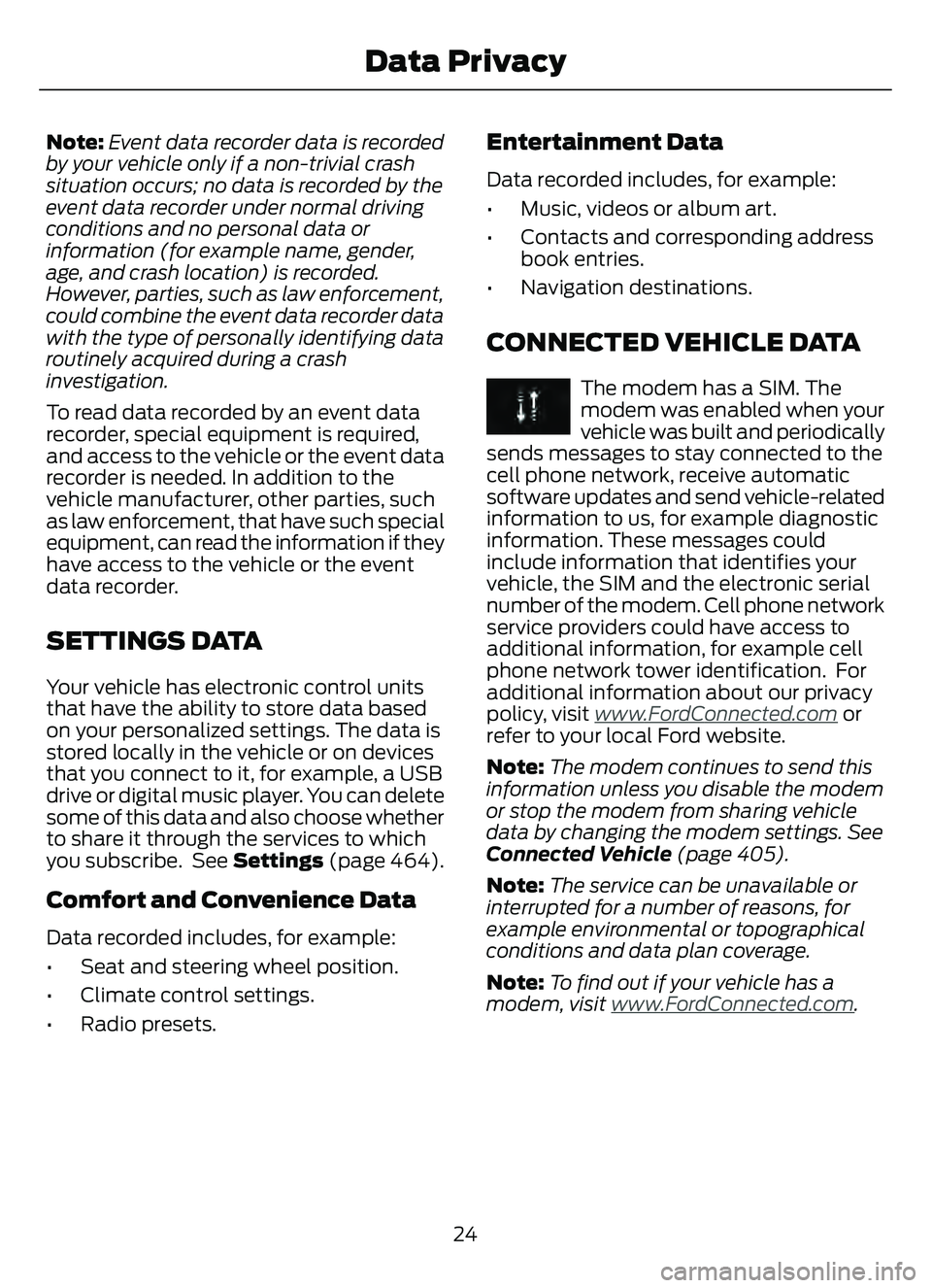
Note:Event data recorder data is recorded
by your vehicle only if a non-trivial crash
situation occurs; no data is recorded by the
event data recorder under normal driving
conditions and no personal data or
information (for example name, gender,
age, and crash location) is recorded.
However, parties, such as law enforcement,
could combine the event data recorder data
with the type of personally identifying data
routinely acquired during a crash
investigation.
To read data recorded by an event data
recorder, special equipment is required,
and access to the vehicle or the event data
recorder is needed. In addition to the
vehicle manufacturer, other parties, such
as law enforcement, that have such special
equipment, can read the information if they
have access to the vehicle or the event
data recorder.
SETTINGS DATA
Your vehicle has electronic control units
that have the ability to store data based
on your personalized settings. The data is
stored locally in the vehicle or on devices
that you connect to it, for example, a USB
drive or digital music player. You can delete
some of this data and also choose whether
to share it through the services to which
you subscribe. See Settings (page 464).
Comfort and Convenience Data
Data recorded includes, for example:
• Seat and steering wheel position.
• Climate control settings.
• Radio presets.
Entertainment Data
Data recorded includes, for example:
• Music, videos or album art.
• Contacts and corresponding address
book entries.
• Navigation destinations.
CONNECTED VEHICLE DATA
The modem has a SIM. The
modem was enabled when your
vehicle was built and periodically
sends messages to stay connected to the
cell phone network, receive automatic
software updates and send vehicle-related
information to us, for example diagnostic
information. These messages could
include information that identifies your
vehicle, the SIM and the electronic serial
number of the modem. Cell phone network
service providers could have access to
additional information, for example cell
phone network tower identification. For
additional information about our privacy
policy, visit www
.FordConnected.com or
refer to your local Ford website.
Note: The modem continues to send this
information unless you disable the modem
or stop the modem from sharing vehicle
data by changing the modem settings. See
Connected Vehicle (page 405).
Note: The service can be unavailable or
interrupted for a number of reasons, for
example environmental or topographical
conditions and data plan coverage.
Note: To find out if your vehicle has a
modem, visit www
.FordConnected.com.
24
Data Privacy
Page 30 of 585
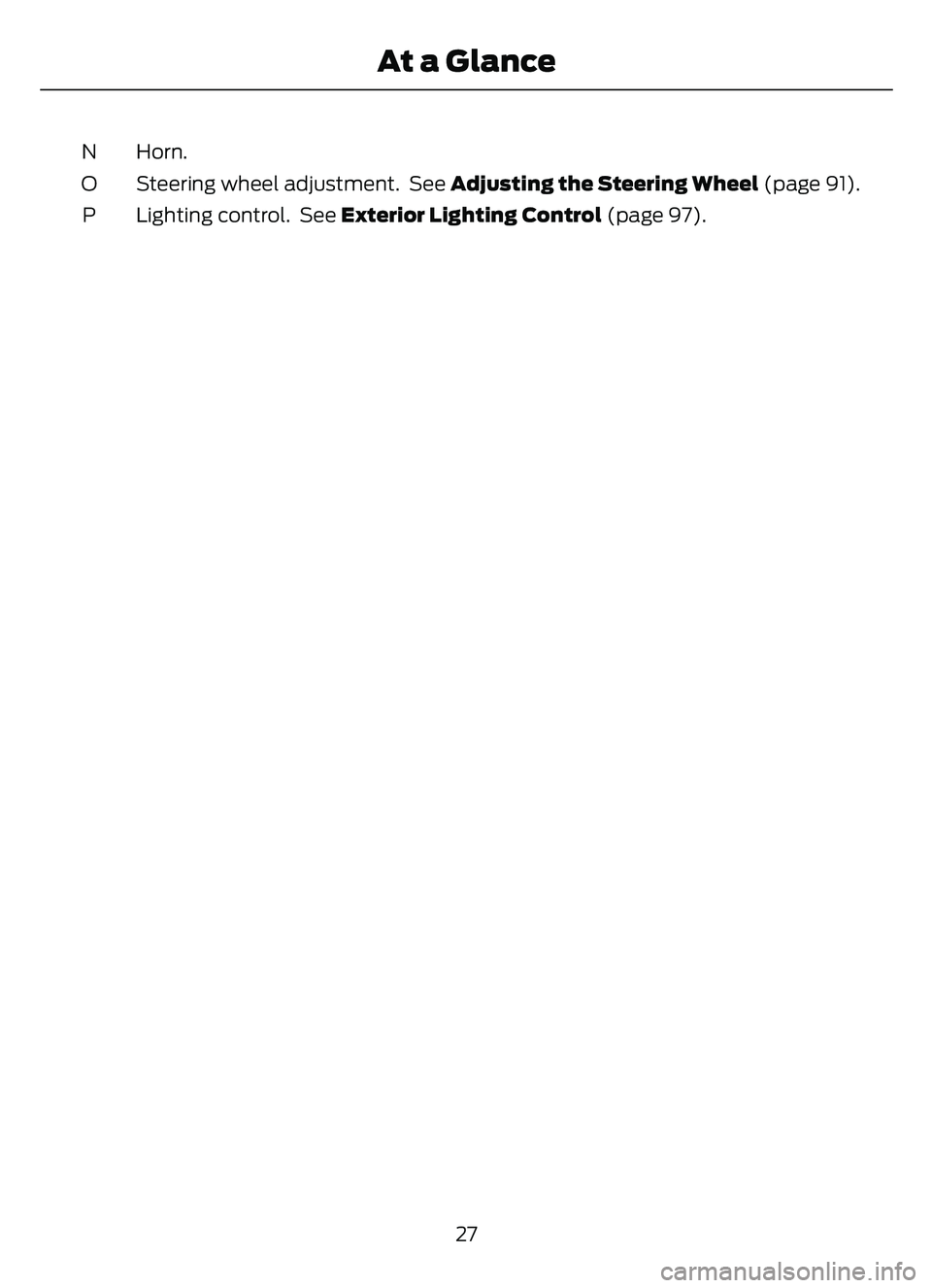
Horn.
N
Steering wheel adjustment. See Adjusting the Steering Wheel (page 91).
O
Lighting control. See Exterior Lighting Control (page 97).
P
27
At a Glance
Page 46 of 585
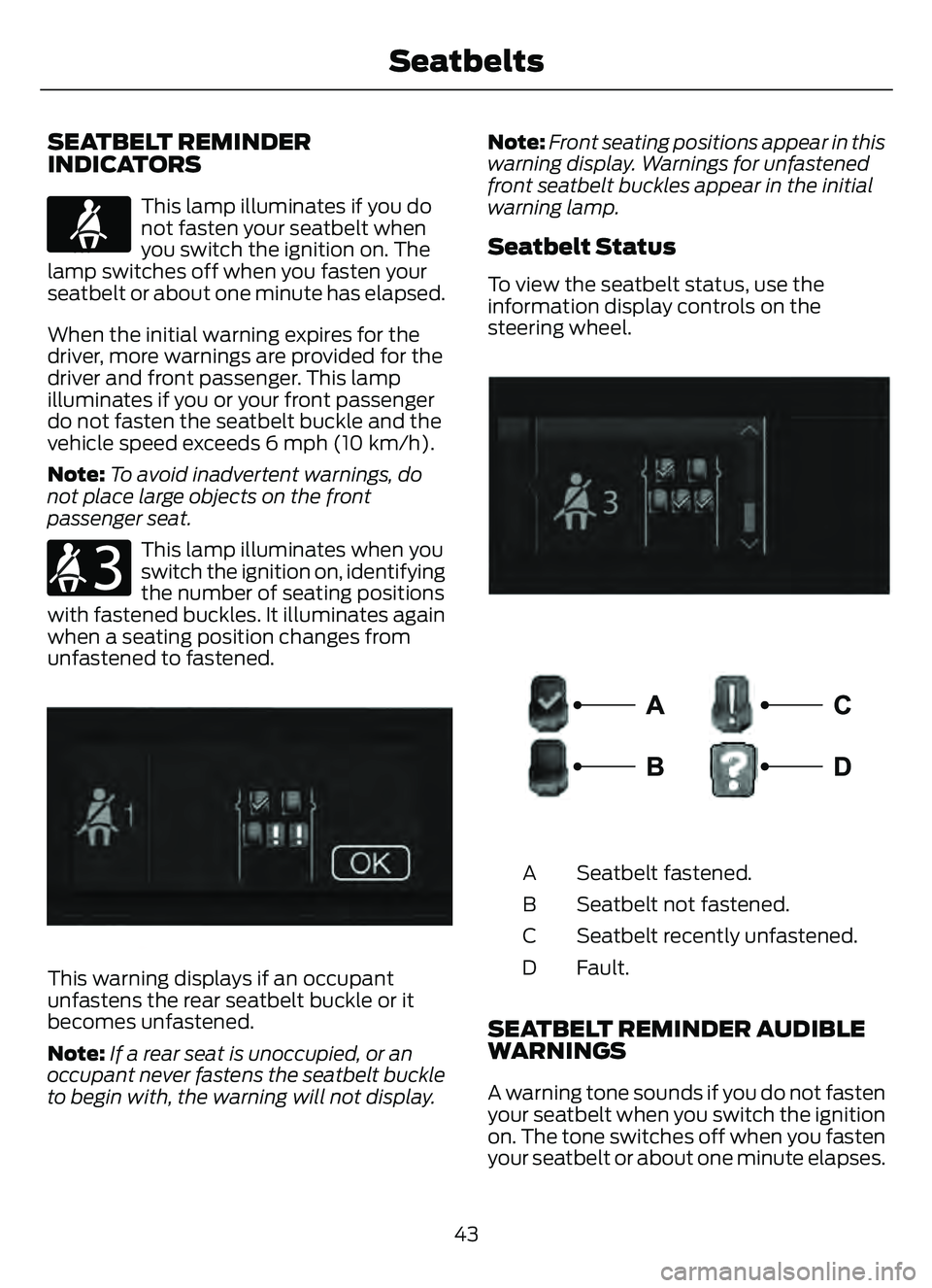
SEATBELT REMINDER
INDICATORS
E71880
This lamp illuminates if you do
not fasten your seatbelt when
you switch the ignition on. The
lamp switches off when you fasten your
seatbelt or about one minute has elapsed.
When the initial warning expires for the
driver, more warnings are provided for the
driver and front passenger. This lamp
illuminates if you or your front passenger
do not fasten the seatbelt buckle and the
vehicle speed exceeds 6 mph (10 km/h).
Note: To avoid inadvertent warnings, do
not place large objects on the front
passenger seat.
E206718
This lamp illuminates when you
switch the ignition on, identifying
the number of seating positions
with fastened buckles. It illuminates again
when a seating position changes from
unfastened to fastened.
E331448E331448
This warning displays if an occupant
unfastens the rear seatbelt buckle or it
becomes unfastened.
Note: If a rear seat is unoccupied, or an
occupant never fastens the seatbelt buckle
to begin with, the warning will not display. Note:
Front seating positions appear in this
warning display. Warnings for unfastened
front seatbelt buckles appear in the initial
warning lamp.
Seatbelt Status
To view the seatbelt status, use the
information display controls on the
steering wheel.
E281361E281361
03E274703
Seatbelt fastened.
A
Seatbelt not fastened.
B
Seatbelt recently unfastened.
C
Fault.
D
SEATBELT REMINDER AUDIBLE
WARNINGS
A warning tone sounds if you do not fasten
your seatbelt when you switch the ignition
on. The tone switches off when you fasten
your seatbelt or about one minute elapses.
43
Seatbelts
Page 52 of 585
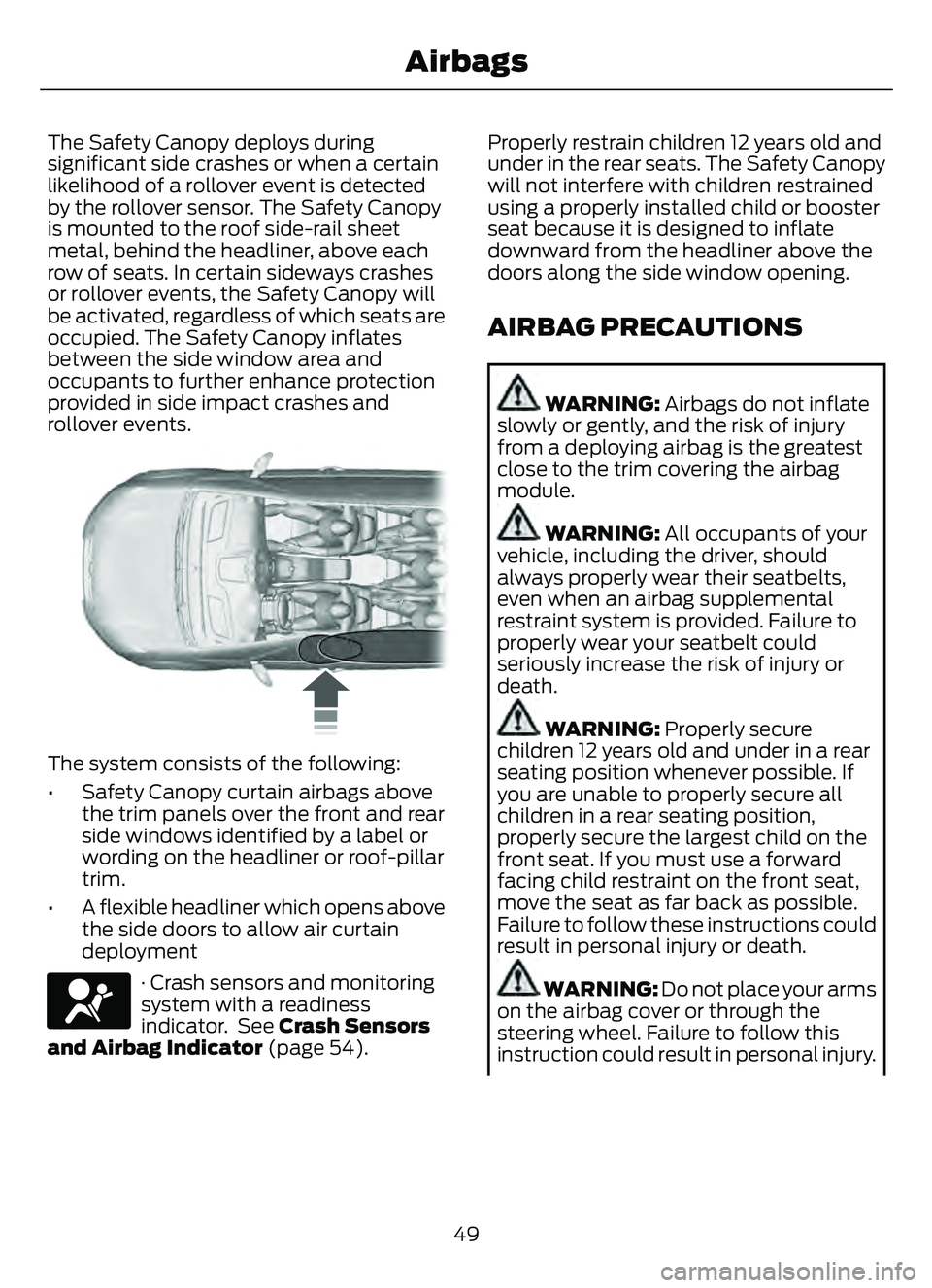
The Safety Canopy deploys during
significant side crashes or when a certain
likelihood of a rollover event is detected
by the rollover sensor. The Safety Canopy
is mounted to the roof side-rail sheet
metal, behind the headliner, above each
row of seats. In certain sideways crashes
or rollover events, the Safety Canopy will
be activated, regardless of which seats are
occupied. The Safety Canopy inflates
between the side window area and
occupants to further enhance protection
provided in side impact crashes and
rollover events.
E75004E75004
The system consists of the following:
€ Safety Canopy curtain airbags abovethe trim panels over the front and rear
side windows identified by a label or
wording on the headliner or roof-pillar
trim.
€ A flexible headliner which opens above the side doors to allow air curtain
deployment
E67017
· Crash sensors and monitoring
system with a readiness
indicator. See Crash Sensors
and Airbag Indicator (page 54). Properly restrain children 12 years old and
under in the rear seats. The Safety Canopy
will not interfere with children restrained
using a properly installed child or booster
seat because it is designed to inflate
downward from the headliner above the
doors along the side window opening.
AIRBAG PRECAUTIONS
WARNING: Airbags do not inflate
slowly or gently, and the risk of injury
from a deploying airbag is the greatest
close to the trim covering the airbag
module.
WARNING: All occupants of your
vehicle, including the driver, should
always properly wear their seatbelts,
even when an airbag supplemental
restraint system is provided. Failure to
properly wear your seatbelt could
seriously increase the risk of injury or
death.
WARNING: Properly secure
children 12 years old and under in a rear
seating position whenever possible. If
you are unable to properly secure all
children in a rear seating position,
properly secure the largest child on the
front seat. If you must use a forward
facing child restraint on the front seat,
move the seat as far back as possible.
Failure to follow these instructions could
result in personal injury or death.
WARNING: Do not place your arms
on the airbag cover or through the
steering wheel. Failure to follow this
instruction could result in personal injury.
49
Airbags